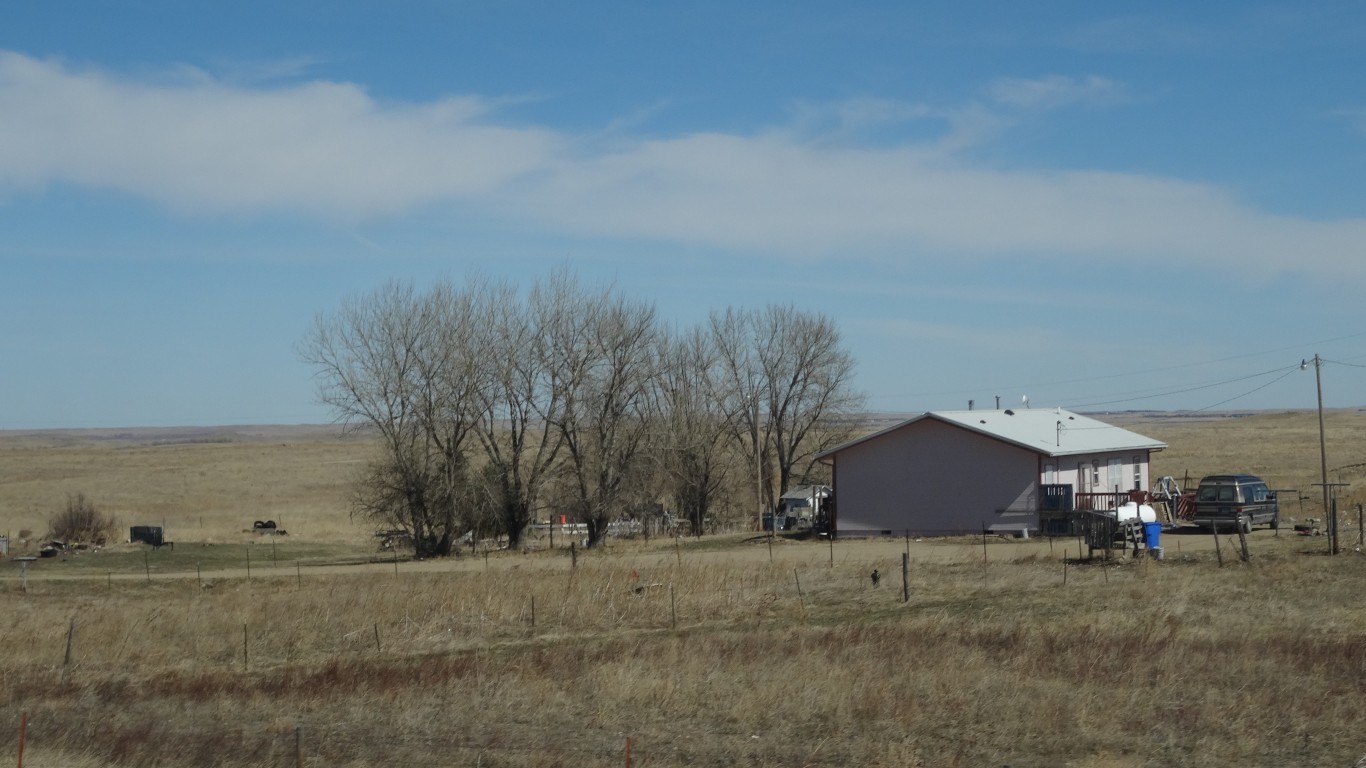
America has long been divided demographically into areas of the country where people have great wealth and education and others where people tend to be poor, sicker than the national average and undereducated. Among the most prominent of the former are the areas of Silicon Valley, around San Jose, and San Francisco. At the far end of the spectrum are some areas of the south, the inner cities of large metropolitan areas and places where there are Native American communities.
[in-text-ad]
While there are countless factors (many of them subjective) that can contribute to or detract from quality of life, there are a few key objective measures that can reveal a great deal about a given area. The United Nations Development Programme identified some of these measures and created the Human Development Index (HDI), a tool to gauge and compare prosperity at a national level from a holistic perspective.
Inspired by the HDI, 24/7 Wall St. created an index of three measures (poverty, life expectancy at birth and bachelor’s degree attainment) to identify the worst U.S. county to live in.
The three measures used to create this list are closely related to each other. People living in poverty are often less able to afford health care or healthy lifestyles, both of which can have serious health repercussions. Similarly, higher educational attainment has been shown to improve health outcomes and reduce the likelihood of unemployment and financial hardship. Both high poverty rates and low educational attainment rates are common in parts of the United States with low life expectancy at birth.
Many of the counties we considered are in rural Appalachian coal country, an area that has been economically decimated by the decline of coal mining in the United States. Once an economic pillar in communities across West Virginia and Kentucky, coal production has precipitously declined in these areas as the U.S. power grid moves away from coal and relies more on cleaner burning natural gas and renewable energy sources.
Most of the remaining counties we considered are in or around American Indian reservations. Native Americans commonly face generational poverty resulting, in part, from their historical mistreatment by the U.S. government. Certain existing conditions in some reservations also affect upward economic mobility. For example, reservation land is often communally owned, making it difficult for residents to build wealth through homeownership.
The worst county to live in is Todd County, South Dakota. Here are the details:
- Poverty rate: 55.5%
- Adults with a bachelor’s degree: 15.6%
- Life expectancy at birth: 66.7 years
- Total population: 10,195
- Largest place in county: Rosebud
[in-text-ad]
Todd County, which covers part of the Rosebud Indian Reservation along the state’s southern border, ranks as the worst place to live in the country. In part, that is because it is the poorest place in the country. Due to a number of historical and contemporary factors, Native American populations are among the most disadvantaged in the United States. More than 55% of the county’s population lives below the poverty line, more than four times the national poverty rate of 13.4%. Most households in the area earn less than $25,000 a year.
As is the case in most impoverished areas in the United States, public health outcomes are also below average in Todd County. Life expectancy at birth in the county is less than 67 years, more than 12 years below the national average. While poverty contributes to poor health outcomes in the area, so do unhealthy behaviors. For example, smoking is the leading cause of preventable death in the United States, and in Todd County, 41.5% of adults smoke, the largest share of any U.S. county.
Methodology: To determine the worst U.S. county to live in, 24/7 Wall St. constructed an index of three measures: poverty, bachelor’s degree attainment among adults and average life expectancy at birth.
Data on the share of individuals living below the poverty line, as well as the share of adults 25 and older with at least a bachelor’s degree, came from the 2019 U.S. Census Bureau’s American Community Survey (ACS) and are five-year estimates.
Data on average life expectancy at birth came from the 2020 County Health Rankings, a joint program of the Robert Wood Johnson Foundation and University of Wisconsin Population Health Institute, and is based on mortality data from the years 2016 to 2018.
Supplemental data on population, income and median home value are five-year estimates from the ACS. Data on unemployment in January 2021 came from the Bureau of Labor Statistics and is not seasonally adjusted. Data on the number of annual drug deaths per 100,000 residents came from the Centers for Disease Control and Prevention and is for the years 2015 to 2019.
Click here to see all the worst counties to live in.
The Average American Has No Idea How Much Money You Can Make Today (Sponsor)
The last few years made people forget how much banks and CD’s can pay. Meanwhile, interest rates have spiked and many can afford to pay you much more, but most are keeping yields low and hoping you won’t notice.
But there is good news. To win qualified customers, some accounts are paying almost 10x the national average! That’s an incredible way to keep your money safe and earn more at the same time. Our top pick for high yield savings accounts includes other benefits as well. You can earn up to 3.80% with a Checking & Savings Account today Sign up and get up to $300 with direct deposit. No account fees. FDIC Insured.
Click here to see how much more you could be earning on your savings today. It takes just a few minutes to open an account to make your money work for you.
Our top pick for high yield savings accounts includes other benefits as well. You can earn up to 4.00% with a Checking & Savings Account from Sofi. Sign up and get up to $300 with direct deposit. No account fees. FDIC Insured.
Thank you for reading! Have some feedback for us?
Contact the 24/7 Wall St. editorial team.




